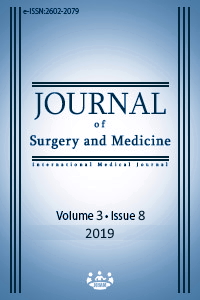Effect of cardiac rehabilitation on mortality related inflammatory markers
Keywords:
Cardiac rehabilitation, Inflammation, MortalityAbstract
Aim: Cardiac Rehabilitation (CR) is a rehabilitation method which decreases mortality in cardiac patients. The main goal of this study is to investigate the effect of CR on neutrophil-to-lymphocyte ratio (NLR) and thrombocyte-to-lymphocyte ratio (TLR), which are inflammatory markers directly related to mortality in cardiac patients. The secondary goal is to assess the effect of CR on functional capacity.
Methods: This retrospective cohort study consists of 211 CR patients who completed 30 sessions of tailored comprehensive CR programs. Their functional status and cardiovascular endurance were assessed with a 6- minute walk test and a cycle ergometer test. Inflammatory markers (TLR, NLR, sedimentation, CRP) were obtained from blood testing and demographic data were collected. After 30 sessions of CR all tests were repeated. No adverse events occurred during the exercise sessions.
Results: Among 211 patients enrolled in this the study, 114 (%54) were female and 97 (%46) were male. Mean age was 56.28 (10.25) years (min 21 - max 81 years). 94 (%44.5) patients were hypertensive, 24 (%11.4) had heart failure, 83 (%39.3) had coronary artery disease and 10 (%4.7) had arrhythmia. Mean range for the 6-minute walk test was 374.62 (61.75) meters before and 390.80 (62.87) meters after CR (P<0.001). Mean values of the maximum watts in cycle ergometer effort test were 50 watts before and 75 watts after CR (P<0.001). Before and after CR, NLR and TLR were 1.6, 1.4 and 107.59 (35.22), 101.46 (32.78), respectively (P<0.001). Sedimentation and CRP levels were 22.38 (11.55) mm/hour, 1.0 mg/dl before and 18.98 (10.06) mm/hour, 0.5 md/dl after rehabilitation, respectively (P<0.001).
Conclusion: CR can decrease the inflammatory markers TLR and NLR which are directly related to mortality in cardiac patients, while increasing the patients’ functional capacity.
Downloads
References
Libby P. Inflammation in atherosclerosis. Nature. 2002;420:868–74.
Libby P, Ridker PM and Hansson GK. Inflammation in atherosclerosis: from pathophysiology to practice. J Am Coll Cardiol. 2009;54:2129–38.
De Caterina R, D’Ugo E. and Libby P. Inflammation and thrombosis - testing the hypothesis with anti-inflammatory drug trials. Thromb Haemost. 2016;116:1012–21.
Gibson PH, Croal BL, Cuthbertson BH, Small GR, Ifezulike AI, Gibson G, et al. Preoperative neutrophil lymphocyte ratio and outcome from coronary artery bypass grafting. Am Heart J. 2007;154(5):995–1002.
Chao-Hui Dong, Zhang-Min Wang, Si-Yu Chen, Neutrophil to lymphocyte ratio predict mortality and major adverse cardiac events in acute coronary syndrome: A systematic review and meta-analysis, Clinical Biochemistry. 2018;52:131-6.
Pourafkari L, Wang CK, Tajlil A, Afshar AH, Schwartz M, Nader ND. Platelet–lymphocyte ratio in prediction of outcome of acute heart failure. Biomarkers in Medicine. 2018;12:63–70.
Ommen SR, Hammill SC, Gibbons RJ. The relative lymphocyte count predicts death in patients receiving implantable cardioverter defibrillators. Pacing Clin Electrophysiol 2002;25(10):1424–8.
Acanfora D, Gheorghiade M, Trojano L, Furgi G, Pasini E, Picone C, et al. Relative lymphocyte count: a prognostic indicator of mortality in elderly patients with congestive heart failure. Am Heart J. 2001;142(1):167–73.
Zouridakis EG, Garcia-Moll X, Kaski JC. Usefulness of the blood lymphocyte count in predicting recurrent instability and death in patients with unstable angina pectoris. Am J Cardiol. 2000;86(4):449–51.
Ommen SR, Gibbons RJ, Hodge DO, Thomson SP. Usefulness of the lymphocyte concentration as a prognostic marker in coronary artery disease. Am J Cardiol. 1997;79(6):812–4.
Leon AS, Franklin BA, Costa F, Balady GJ, Berra KA, Stewart KJ, et al. Cardiac rehabilitation and secondary prevention of coronary heart disease: An American Heart Association scientific statement from the Council on Clinical Cardiology (Subcommittee on Exercise, Cardiac Rehabilitation, and Prevention) and the Council on Nutrition, Physical Activity, and Metabolism (Subcommittee on Physical Activity), in collaboration with the American association of Cardiovascular and Pulmonary Rehabilitation. Circulation. 2005;111:369–76.
Balady GJ, Williams MA, Ades P, Bittner V, Comoss P, Foody JM, et al. Core components of cardiac rehabilitation/secondary prevention programs: 2007 update: A scientific statement from the American Heart Association Exercise, Cardiac Rehabilitation, and Prevention Committee, the Council on Clinical Cardiology; the Councils on Cardiovascular Nursing, Epidemiology and Prevention, and Nutrition, Physical Activity, and Metabolism; and the American Association of Cardiovascular and Pulmonary Rehabilitation. Circulation. 2007;115:2675–82.
Anderson L, Thompson DR, Oldridge N, Zwisler A, Rees K, Martin N, Taylor RS. Exercise-based cardiac rehabilitation for coronary heart disease. Cochrane Database of Systematic Reviews. 2016(1):CD001800.
Kabboul NN, Tomlinson G, Francis TA, Sherry LG, Gabriela C, Valeria R, et al. Comparative Effectiveness of the Core Components of Cardiac Rehabilitation on Mortality and Morbidity: A Systematic Review and Network Meta-Analysis. J Clin Med. 2018;7(12):514.
Butter C, Groß J, Haase-Fielitz A, Helen S, Cornelia D, Peter B, Michael N. Impact of Rehabilitation on Outcomes after TAVI: A Preliminary Study. J Clin Med. 2018;7(10):326.
Fest J, Ruiter TR, Groot Koerkamp B, Dimitris Rizopoulos M, Arfan I, Casper H J van Eijck, et al. The neutrophil-to-lymphocyte ratio is associated with mortality in the general population: The Rotterdam Study Eur J Epidemiol. 2019;34:463.
Turgay Yıldırım, Ö, Akşit, E, Aydın F, Hüseyinoglu Aydın A , Dağtekin E .Can neutrophil to lymphocyte ratio and platelet to lymphocyte ratio be used as biomarkers for non-dipper blood pressure? J Surg Med. 2019;3(1):4-7.
Zengin İ , Arı S. Effect of cardiac rehabilitation on neutrophil-to-lymphocyte ratio and platelet-to-lymphocyte ratio in ST elevation myocardial infarction patients. Eur Res J. 2019;early pub doi: 10.18621/eurj.447027
Pasquali SK, Alexander KP, Coombs LP, Lytle BL, Peterson ED. Effect of cardiac rehabilitation on functional outcomes after coronary revascularization. Am Heart J. 2003;145(3):445–51.
Downloads
- 1451 1875
Published
Issue
Section
How to Cite
License
Copyright (c) 2019 Başak Bilir Kaya, Nazmiye Özbilgin
This work is licensed under a Creative Commons Attribution-NonCommercial-NoDerivatives 4.0 International License.
















